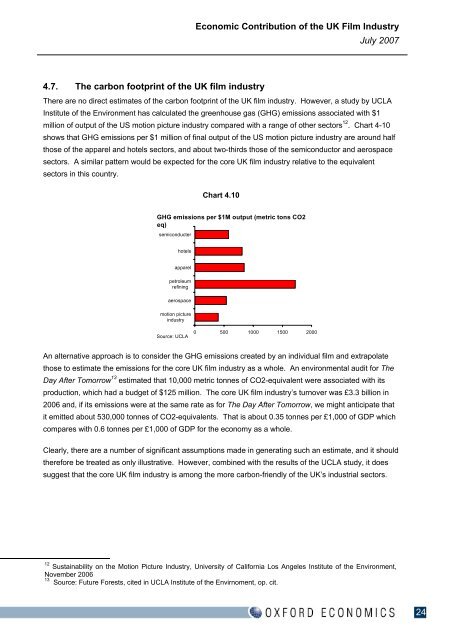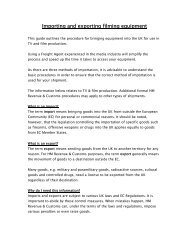The Economic Impact of the UK Film Industry - BFI - British Film ...
The Economic Impact of the UK Film Industry - BFI - British Film ...
The Economic Impact of the UK Film Industry - BFI - British Film ...
Create successful ePaper yourself
Turn your PDF publications into a flip-book with our unique Google optimized e-Paper software.
4.7. <strong>The</strong> carbon footprint <strong>of</strong> <strong>the</strong> <strong>UK</strong> film industry<br />
<strong>Economic</strong> Contribution <strong>of</strong> <strong>the</strong> <strong>UK</strong> <strong>Film</strong> <strong>Industry</strong><br />
July 2007<br />
<strong>The</strong>re are no direct estimates <strong>of</strong> <strong>the</strong> carbon footprint <strong>of</strong> <strong>the</strong> <strong>UK</strong> film industry. However, a study by UCLA<br />
Institute <strong>of</strong> <strong>the</strong> Environment has calculated <strong>the</strong> greenhouse gas (GHG) emissions associated with $1<br />
million <strong>of</strong> output <strong>of</strong> <strong>the</strong> US motion picture industry compared with a range <strong>of</strong> o<strong>the</strong>r sectors 12 . Chart 4-10<br />
shows that GHG emissions per $1 million <strong>of</strong> final output <strong>of</strong> <strong>the</strong> US motion picture industry are around half<br />
those <strong>of</strong> <strong>the</strong> apparel and hotels sectors, and about two-thirds those <strong>of</strong> <strong>the</strong> semiconductor and aerospace<br />
sectors. A similar pattern would be expected for <strong>the</strong> core <strong>UK</strong> film industry relative to <strong>the</strong> equivalent<br />
sectors in this country.<br />
Chart 4.10<br />
GHG emissions per $1M output (metric tons CO2<br />
eq)<br />
semiconducter<br />
hotels<br />
apparel<br />
petroleum<br />
refining<br />
aerospace<br />
motion picture<br />
industry<br />
Source: UCLA<br />
0 500 1000 1500 2000<br />
An alternative approach is to consider <strong>the</strong> GHG emissions created by an individual film and extrapolate<br />
those to estimate <strong>the</strong> emissions for <strong>the</strong> core <strong>UK</strong> film industry as a whole. An environmental audit for <strong>The</strong><br />
Day After Tomorrow 13 estimated that 10,000 metric tonnes <strong>of</strong> CO2-equivalent were associated with its<br />
production, which had a budget <strong>of</strong> $125 million. <strong>The</strong> core <strong>UK</strong> film industry’s turnover was £3.3 billion in<br />
2006 and, if its emissions were at <strong>the</strong> same rate as for <strong>The</strong> Day After Tomorrow, we might anticipate that<br />
it emitted about 530,000 tonnes <strong>of</strong> CO2-equivalents. That is about 0.35 tonnes per £1,000 <strong>of</strong> GDP which<br />
compares with 0.6 tonnes per £1,000 <strong>of</strong> GDP for <strong>the</strong> economy as a whole.<br />
Clearly, <strong>the</strong>re are a number <strong>of</strong> significant assumptions made in generating such an estimate, and it should<br />
<strong>the</strong>refore be treated as only illustrative. However, combined with <strong>the</strong> results <strong>of</strong> <strong>the</strong> UCLA study, it does<br />
suggest that <strong>the</strong> core <strong>UK</strong> film industry is among <strong>the</strong> more carbon-friendly <strong>of</strong> <strong>the</strong> <strong>UK</strong>’s industrial sectors.<br />
12<br />
Sustainability on <strong>the</strong> Motion Picture <strong>Industry</strong>, University <strong>of</strong> California Los Angeles Institute <strong>of</strong> <strong>the</strong> Environment,<br />
November 2006<br />
13<br />
Source: Future Forests, cited in UCLA Institute <strong>of</strong> <strong>the</strong> Envirnoment, op. cit.<br />
24

















